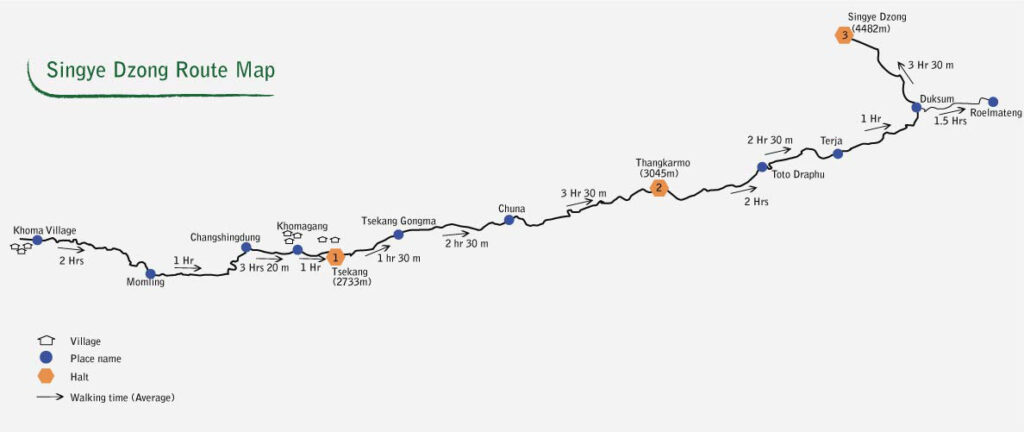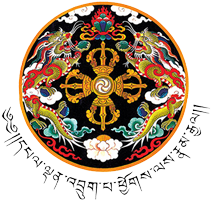Singye Dzong
- Name: Singye Dzong
- Caretaker: Sangay Tshering
- Contact No: 17561618
- Location: Singye Dzong
- Gewog: Khoma
- Dzongkhag: Lhuentse
- Ownership: Government
- Year of Foundation: 8th century
Singye Dzong is one of Bhutan’s most sacred sites, renowned for being visited by Guru Rinpoche. Thousands of pilgrims make the journey to Singye Dzong each year to offer their prayers and seek spiritual blessings. Located within the Bumdeling Wildlife Sanctuary, near the Tibetan border, Singye Dzong is accessible via a three-day trek from the roadhead at Kildung under Khoma Gewog, Lhuentse.
The surrounding area is pristine, with clean air and beautiful high-altitude flowers that add to the serenity of the location. Pilgrims and visitors can enjoy the peaceful atmosphere, with fresh mountain air and a calm environment that invites rest and reflection. The main religious relic at Singye Dzong is the Phurpa Terma, a sacred artifact that draws many devotees.

At present, Singye Dzong has a Drupdey (meditation center) headed by a lama, with seven monks meditating in retreat. In addition, the center accommodates 12 monks participating in a three-year retreat focused on intense spiritual practice. The two main monasteries in the area are Gawa Dzong and Singye Dzong, both revered by the local communities and visitors alike.
The nearest villages to Singye Dzong are Khomagang and Denchung, which serve as the last communities before reaching this sacred destination.
Singye Dzong – The mystical Lion Fortress
A personal narrative of the journey to Singye Dzong- By Tshering Chuki Gyamtsho
Atop a ridge overlooking the Kurichhu River stands Lhuendrup Rinchentse Dzong—The Fortress of the Precious Peak of Spontaneous Fulfillment. According to the National Library of Bhutan, the Dzong was originally constructed in 1554 by Yongzin Ngagi Wangchuck, the youngest son of the great Drukpa Lama Ngawang Choegyal, as a meditation center. The present structure, according to Legshey Phendhey Wangchuk, was built in 1665 during the tenure of Trongsa Penlop Chogyel Minjur Tenpa. It was during this time that a Rabdey (monastic body) was instituted by the 4th Desi, Gyalsey Tenzin Rabgay.
Another account suggests that Yongzin Ngagi Wangchuck first meditated at Timula before searching for a winter retreat. Upon arriving at the current site of Lhuentse Dzong, he encountered a local deity in the form of a white, bleating goat, which he took as a positive omen. He built a temple there, naming it LeyLey Dzong (the Fortress of the Goat) after the sound of the goat’s bleat. According to another story, a stone below the Dzong is shaped like a goat, and it is said that this stone bleated, reinforcing the name. Yet another version mentions a rock below Minjey village shaped like a frog, which, bizarrely, also bleated like a goat. This was considered an unfavorable sign, leading the people to relocate the Dzong to its present site.
Later, Zhabdrung Ngawang Namgyel, following in the footsteps of his ancestor Yongzin Ngagi Wangchuck, visited Kurtoe Lhuentse Phodrang. During his visit, he planned to build a new Dzong to unify the region, but his efforts were thwarted due to conflicts among the local kings. However, Zhabdrung prayed that the Dzong would eventually be built and that the entire Kuri Dozhi region would come under the control of the central government.
In 1654, a combined force led by Gawa, the King of Phagidung, and Dharma, the King of Kidling, launched an unprovoked attack on Timula Dzongpoen Lhadhar. At the time, a civil war between Choetse Penlop Chogyel Minjur Tenpa and Bumthang Choekhor Dhepa had recently ended, and the victorious forces of the Choetse Penlop and Druk Desi were celebrating in Bumthang. When the relatives of Dzongpoen Lhadhar heard of this, they sought help from the Choetse Penlop. Aware of Zhabdrung’s prophecy to bring the Kurtoe region under central control, the Penlop agreed to assist. The combined forces of the Druk Desi and Choetse Penlop then marched towards Kurtoe, capturing the two kings and bringing the region under the control of the central government.
Pilgrim Centers
Lhuentse is home to numerous pilgrimage sites, many of which are closely associated with Guru Rinpoche and various tertons (treasure discoverers). Some of the most sacred sites include Singye Dzong, Rinchen Bumpa, Phuningla, Ney Khenpajong, and Sangwai Dadru. Additionally, several of the region’s oldest lhakhangs were constructed by prominent Buddhist masters such as Guru Chowang, Ratna Lingpa, Pema Lingpa, Khedrup Kuenga Wangpo, and Yongzin Ngagi Wangchuk. These include Menkhar, Karphu, Lukchu, Kuenzangling, Goshogpang, Timula, Khochung Lhakhang, and Dungkar Choejee Naktsang.
Dungkar Khetangbi Naktsang, the birthplace of Jigme Namgyel, stands in its original splendor as a historical monument. Meanwhile, a 149-foot statue of Guru Rinpoche, set to be the tallest in the world, is under construction at Takila in Menbi Gewog, further enhancing the region’s spiritual significance.
Singye Dzong & Roelmateng
Description
There are five main sacred places associated with Guru Rinpoche, the figure who brought Buddhism to Bhutan. These are known as the sacred places of the body, speech, mind, qualities, and activity. Singye Dzong is regarded as the most sacred site associated with activity, while the other four primary sacred places are located in Tibet. Within Singye Dzong, there are eight sacred locations, all referred to as Dzongs. Visiting all these Dzongs takes about a day, while an additional two days is needed to explore Tshokar, Tshona, Terday Lhatsog and Yumthramo. A three-hour walk to the east leads to Rolmateng Ney, which may require another day to visit its main sacred sites.
According to the descriptions of these sacred places, a visit to Singye Dzong can liberate one from being reborn in lower realms and fulfill one’s wishes and prayers.
Route / Lodge
The journey to Singye Dzong commences from Kildung, a designated road point, and spans three days. Pilgrims are required to make two overnight halts: the first at either Khomagang or Tsikhang, and the second at Thangkarmo. It is advisable to begin early on the first day to ensure arrival at Tsikhang before nightfall. For a detailed route map, please refer to the Singye Dzong Route Map. While the route is generally safe, caution is imperative, particularly at sections with steep cliffs, where a minor misstep could prove fatal.
The first overnight stay can be arranged at homestays in Khomagang or the guesthouse in Tsikhang. Guests will appreciate the tranquil sounds of the Khomachhu, as both villages are located along the right bank of the stream. To avoid accommodation complications, all groups are encouraged to inform the homestays in advance.
The second overnight halt is at Thangkarmo, which is situated in a remote wilderness area with no neighboring villages, apart from a small guesthouse. Visitors are advised to carry adequate provisions and sleeping bags for their overnight stay.
Travel and Health Advisory Note
All visitors are required to obtain a travel permit from the Khoma Gewog Centre, for which a nominal fee applies. Prior to acquiring the permit, it is essential for individuals to undergo thorough medical checkups to ensure their preparedness for the trip. Those with hypertension or heart conditions are strongly advised to consult their physicians. If they have such medical issues, it is crucial to heed their physician’s advice seriously if they wish to proceed with their pilgrimage to Singye Dzong.
For those interested in hiring horses, please contact Mr. Pema Tshering, the Khoma Mangmi, at 17303515 at least one week in advance to facilitate the necessary arrangements.
When to Visit
The advisable season for visiting Singye Dzong is from March to May, August to October. The best time is from the last week of September to the second week of October when there is minimal rainfall and snowfall. If you plan to visit during the summer, please confirm the condition of the footpath beforehand.
Climate
Situated at an altitude of 3,894 meters above sea level, Singye Dzong is relatively colder than many other places. The altitudes of Tshokar (4,655 meter), Tshona (4,511 meters), and Terdag Lhatshog are even higher, subjecting visitors to harsher climatic conditions.
Dress
When trekking to Singye Dzong, appropriate dress is crucial for both comfort and respect for the sacred nature of the site. Here are specific dress code recommendations:
- Modest Clothing: Since Singye Dzong is a highly sacred religious site, it is important to dress modestly. This includes wearing long sleeves and long pants to show respect. Avoid revealing clothing such as shorts or sleeveless tops, especially when visiting the dzongs or sacred areas.
- Layered Clothing: Due to the high altitude (3,894 meters) and fluctuating temperatures, wearing layers is essential. Start with moisture-wicking base layers, add insulating layers like fleece or wool, and top it with a waterproof and windproof outer layer to protect against rain and cold.
- Warm Outerwear: The temperatures can drop significantly at night, so ensure you have a warm jacket, preferably insulated, to wear during the evenings or at higher elevations.
- Comfortable Trekking Gear: Wear sturdy, weatherproof trekking pants and avoid jeans or other heavy fabrics that don’t dry quickly. Lightweight, quick-drying clothing is ideal for the varying conditions along the trek.
- Footwear: In addition to the dress code for modesty, ensure you wear good-quality trekking boots that are waterproof and offer ankle support. Carry a pair of comfortable walking shoes for use at camps or during lighter portions of the hike.
- Headgear and Gloves: A warm hat or beanie is recommended for cold mornings and evenings. Gloves, preferably insulated and waterproof, are also advisable, especially at higher altitudes where temperatures drop.
- Cultural Respect: When entering religious sites within Singye Dzong, remove your hats and shoes as a sign of respect. Carry a kabney (traditional Bhutanese scarf) if you plan to enter sacred spaces, as it is customary for men to wear one. Women should consider wearing a modest scarf or shawl.
Contact us
- Dzongkhag Administration Lhuentse, Bhutan
- HRO@04545136
- PA to Dzongdag@04545101
- Email(PA)@tchoki@lhuentse.gov.bt
